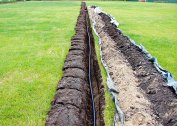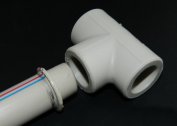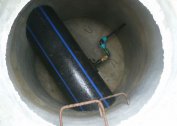When designing and constructing water supply and sewage systems, it is necessary to rely on current building codes and rules. The main documents that regulate such processes are called SNiPs and codes of rules (SP).
SNiP 2. 04. 01 - 85 * Internal water supply and sewerage of buildings
 The norms set forth in the document are used in the design of domestic hot and cold water supply, sewage and gutters. These networks should be present in buildings erected in sewer zones. In other areas, the presence of these communications is mandatory in the following facilities:
The norms set forth in the document are used in the design of domestic hot and cold water supply, sewage and gutters. These networks should be present in buildings erected in sewer zones. In other areas, the presence of these communications is mandatory in the following facilities:
- houses above 2 floors;
- public buildings: hotels, clinics, dispensaries, schools, kindergartens;
- athletic facilities;
- catering enterprises;
- nursing home.
There is no sewage in industrial buildings if there is no water supply, and the number of workers does not exceed 25 people per shift. In such cases, backlash closets or cesspools are equipped.
In the construction of internal networks use pipes, equipment and materials that comply with existing state standards, technical conditions. When transporting and storing drinking-quality water, the requirements of the Sanitary Inspection of Russia are taken into account.
When designing an internal water supply and sewage system, it is necessary to use progressive structural and technological solutions. This implies the use of prefabricated and standard products, parts that are produced in the factory, the mechanization of labor when performing labor-intensive operations.
SP 30.13330.2012 Internal water supply and sewerage of buildings
 The joint venture for internal water supply and sewage is an updated version of SNiP 2.04.01-85 *. The normative document applies to the engineering networks of buildings for various purposes, the height of which does not exceed 75 m. The joint venture for internal water supply and sanitation is not used in the design:
The joint venture for internal water supply and sewage is an updated version of SNiP 2.04.01-85 *. The normative document applies to the engineering networks of buildings for various purposes, the height of which does not exceed 75 m. The joint venture for internal water supply and sanitation is not used in the design:
- heat points;
- fire water supply;
- automatic fire extinguishing systems;
- installations for the treatment of hot water;
- special water supply systems.
When designing engineering networks, NSCs are also used - integrated standards of construction prices. They help determine the need for cash, plan the amount of investment in the creation of capital objects.
SNiP No. 2. 04. 02 - 84 * - external networks and structures, water supply
 The normative document is used in the design of external centralized water supply networks in settlements and national economy facilities. At the same time, existing schemes for the development, use and protection of waters, master plans of cities and industrial units are additionally taken into account. When designing a water supply system, the characteristics of existing or planned drainage systems are simultaneously taken into account.
The normative document is used in the design of external centralized water supply networks in settlements and national economy facilities. At the same time, existing schemes for the development, use and protection of waters, master plans of cities and industrial units are additionally taken into account. When designing a water supply system, the characteristics of existing or planned drainage systems are simultaneously taken into account.
During the installation of integrated economic, industrial, drinking water supply systems, it is necessary to provide security zones for water supply sources, structures and pipelines. The quality of the water supplied must comply with GOST 2874–82. When erecting external networks, materials that do not contradict the rules of the State Sanitary and Epidemiological Supervision are used.
Water supplied for production needs must meet technological requirements.It is important that it does not negatively affect the products and meet the needs of staff. Water used for irrigation piping must comply with sanitary, agrotechnical and hygienic requirements.
When making important technical decisions, several options are considered. To determine the best, technical and economic calculations are performed.
SNiP 2. 04. 03 - 85 - sewage system, external networks and facilities
 The normative document is used in the design or reconstruction of external networks of permanent sewage. The following information is taken into account:
The normative document is used in the design or reconstruction of external networks of permanent sewage. The following information is taken into account:
- schemes for the development and placement of industrial facilities;
- master plans for industrial units;
- water use and protection schemes;
- development projects of cities and towns;
- layout of production forces by region and district.
When creating a sewage system, the feasibility of cooperating with its main facilities is taken into account. Be sure to determine the availability and operational characteristics of existing networks, the possibility of their use.
Sewerage design takes place in parallel with the development of water supply. The capacities of these networks must correspond to each other, which ensures their effective operation. It is recommended to consider the possibility of recycling pre-treated wastewater and rainwater for industrial or economic purposes.
It is advisable to place external sewage facilities on the territory of enterprises. When connecting industrial networks to intra-quarter or street networks, it is necessary to equip control wells. They are placed outside the enterprise. At the same time, it is necessary to have devices for controlling the amount of waste that a certain consumer dumps into the sewer network. The discharge of treated effluents into water bodies is agreed with the relevant state bodies.
When designing a sewage system, it is necessary to provide measures to guarantee the uninterrupted operation of the system. When performing repairs or in the event of an accident at one of the structures, the rest should not be overloaded by more than 8-17% of the standard values.
Sewer facilities are located away from residential buildings, food industry enterprises, public buildings. The size of the sanitary protection zone is clearly defined by this regulatory document.
SNiP 3. 05. 01 - 85 - intra-house networks for sanitary purposes
 The standards given in the document apply to internal systems:
The standards given in the document apply to internal systems:
- water supply;
- sewers;
- heating;
- ventilation and air conditioning.
When installing engineering networks, technical specifications and instructions of manufacturers of materials and equipment are taken into account. Installation of intra-house systems for sanitary purposes is carried out by the industrial method using specially manufactured products.
Installation of engineering networks in buildings, the coating of which is formed of large blocks, occurs before they are laid in the design position. The installation of sanitary systems begins after the completion of the installation of floors, walls, partitions.
When developing new and reconstructing existing external networks and structures, it is important to comply with the requirements of design and regulatory documentation. In addition to the indicated SNiP 3.05.04-85, this refers to SNiP 3.01.01-85 *, SNiP 3.01.03-84, SNiP III-4-80 *. Upon completion of installation work on the construction of external networks, when they are put into operation, the requirements of SNiP 3.01.04-87 are taken into account.


